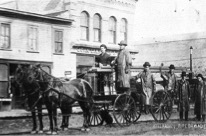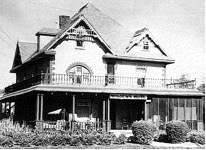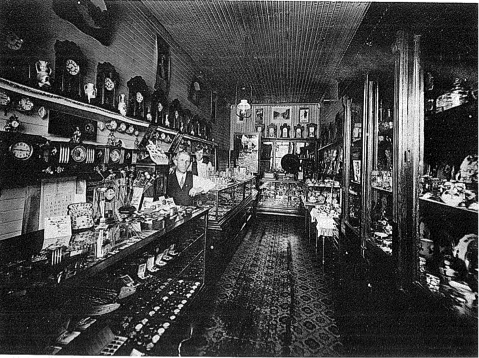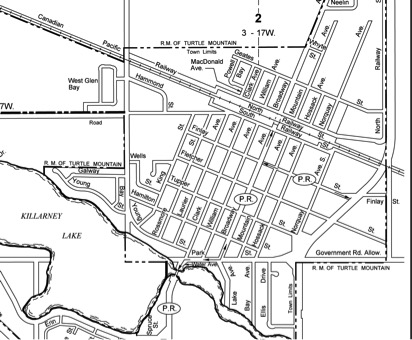Introduction
The
Killarney Community Heritage Site Inventory was carried out over the
summer and fall of 2014. The project was directed by the Killarney
Communities in Bloom Committee. The data collection and presentation
for the project was undertaken by Ken Storie, a consultant hired
through the Historic Resources Branch of Manitoba Culture, Heritage,
Tourism and Sport (with funding from the department’s Heritage Grants
Program).
The first pages include an overview of the Historical Claims of the
region, a look at the Form and Layout of the communities, and a short
review of some of the Notable People from the early years in the
region. This is followed by a list of sites and a collection of maps
that locate all the sites.
The rest of the collection of information is devoted to the Community
Heritage Site Inventory Forms that were created by Mr. Storie – these
have been grouped (with tabbed pages) according to building types. Each
site has been assigned a code based on the community and building
type. More work will be carried out, based on this
inventory, and through rigorous analysis and evaluations, to determine
which buildings and sites in this area might be considered key heritage
resources – those few places that effectively sum up the history of our
community.
It is hoped that many residents of Killarney will participate in the
project by contributing information in the form of corrections and
additions to the inventory pages. In this way, the final project will
incorporate and preserve the collective knowledge of the town for
present and future generations.
Overview
We have attempted to relate these sites to the history of Killarney
through a series of short articles on:
1. Historic Claims of the area
2. Analysis Critera - Where
sites fit
in terms of the Community
Heritage
3. Community Layout
4. Notable
People
The project is intended as a "Beginning" rather than a Finished
Product.
Local groups and individuals are invited to amend and add to it. New
information is always welcome and we will make every effort to add
anthing that is sent to us.
One goal is to collect as much information about our older
buildings as we can. This will be found in the Sites section, and we
would appreciate corrections, additions, comments and questions as we
complete the project.
Community Historical
Claims
Community
Historical Claims
Turtle Mountain was a well-known landmark well before the Euro-settlers
came. Assiniboine and Dakota people camped and hunted on its wooded
slopes, as did Metis hunters and fur traders. The plentiful supply of
wood and water it offered also attracted the first pioneers.
Where once lay the homesteads of John Williams, George Gaetes, and
Samuel Hossack, the prospering town of Killarney now stands.
Other homesteads were scattered throughout the municipality.
George Crawford took up land south of Killarney and was followed by his
brother, William and his family. Samuel Blackwell came in 1880.
The South Western Colonization Railway had surveyed a route that
crossed the municipality on its northern reaches. High and Dougald
Cameron were so confident that their land would be chosen for a station
that they engaged a surveyor to lay out a townsite and gave it the name
Tisdale, after the chief engineer who had surveyed the proposed route.
Their plans were very progressive for the times; they even set aside
seven acres for a park and recreation ground.

The Killarney Fire Brigade – On Broadway
The route changed and the first work train reached Killarney in
December of 1885. The line had been purchased by the CPR by this time.
When the news came that the railway was to follow the southern route,
T.J. Lawlor promptly arranged for his store at Tisdale taken down and
had the lumber transported to Killarney. He found out where the station
was to placed from the Land Commissioner and located his lots on the
southeast corner of Railway Street and Broadway.
A.J. Rollins had recently built on the east side of the “Bay” and moved
it to South Railway Street. Next to it was Mrs. Duffy’s boarding house
, and, on the same street, another boarding house conducted by Mrs.
John Melville. Mr. Bird of Emerson opened the first hardware store.
Most of the business establishments were on Broadway. James McCann
built the Leland Hotel and Alex Gouldie had the Grand Central. Stores
were opened on Broadway by George Robinson, C.W. Williams of Wakopa,
Fred Moule of Portage, and two young men from Peterborough; F.
Kirkpatrick and H.A. Wallis. Later these two gave up the store and
H.A.Wallis opened a Real Estate, Insurance, and Collection Agency, in
competition with one managed by J.W. Smaill. Angus McQueen, a baker
from Scotland opened a shop.
The first doctor on record was Dr. Fawcett who occupied a two-story
building, the lower level being his drug store.
On November 22, 1894, W.W. Hatch brought out the first edition of the
Killarney Guide. He was succeeded as editor and publisher by J.H.
Monteith who retired in 1946, selling the plant to T.E. Wilkins.

Melville House – Morden House – Killarney Hotel
The town continued to grow and prosper. A school, Churches and other
public buildings were erected and, eventually, replaced with more
ambitious buildings. Killarney became thye batural commercial centre of
a thriving agricultural district. It remains so today.
Analysis Criteria
Aboriginal Peoples
When the first settlers arrived in Killarney it was obvious to them
that they were not the first inhabitants of this land. Native people
often passed through and evidence of past inhabitants was more visible
in those days, be it in the form of campsites and prairie trails.
Settlers often encountered and interacted with the Sioux people from
the Turtle Mountain area.
Settlers and Defining Culture
Anticipating the great settlement boom of the 1880’s a trickle of
adventurous souls lead the way into this land in the late 1870’s.
Killarney Lake (Oak lake as it was then called) was attractive in that
it provided ample water as well logs for building and fuel.
Until 1885 settlement focused on the Trading Post of B.B. Lariviere at
Wakopa and scattered post offices such as Tisdale and Rowland. Settlers
approached the district taking the Boundary Commission Trail from
Emerson. Local histories indicate that most of these early settlers
came from Ontario.
Other Settlement/Ethnic Groups
The establishment of the railway thought the region eventually altered
the predominantly Anglo-Saxon settlement somewhat, but many Killarney
families can trace their root back to Ontario. A significant number of
Mennonites have settled in the region and in the town.
Economic Engines
Farming formed the economic basis of virtually all prairie settlements
but many communities have succeeded in establishing relatively
small-scale but significant economic engines, generally related to
agriculture and local resource development. Grist Mills, located
in Wakopa, Holmfield and Killarney are examples.
Commercial Growth
The establishment in 1885 of the town of Killarney in the midst of
well-populated and productive farmland led to an initial burst of
commercial enterprises. The usual banks, general stores, drug and
jewelry stores appeared. Some of these would naturally be housed in
quickly erected-frame buildings, but because the economic importance of
the town seemed quite secure many substantial commercial and
residential building appeared in those first years.

S.G. Grant, jeweler – 1906
Social & Cultural Development
In the summer of 1800 the settlement of the region began in earnest
with the arrival of settlers in all parts of the municipality.
For the first few years after farming operations commenced the
scattered rural nature of settlement in the area was characterized by
various small rural centres. Killarney Post Office opened in 1883,
Lyonshall in 1884. Wakopa had a Post Office as early as 1882.
In most Manitoba communities, the “Establishment” era is defined by the
replacement of “Pioneer” log, sod and rough lumber buildings by more
ambitious constructions of milled lumber. With that definition in mind,
the town of Killarney can be said to have had a relatively short
Pioneer stage. Although a few settlers were on the site, it wasn’t
until the final decision by the railway that a townsite was surveyed
and commerce sprang to life. Having a rail connection meant that all
manner of building materials were readily available.
By the late1890’s these modest began to be replaced, often with larger
two story buildings.
The Consolidation period can be said to have started in about 1900.
Larger, two story homes, some many using local brick, were built.
Several of these homes survive today.
Community Form and Layout
The layout of the town of Killarney was a direct response to the
railway line to which it owes its existence. Like many prairie
communities, it grew primarily on one (south) side of the tracks.
The railway runs west-east and the town was surveyed to conform.
Broadway Avenue, which quickly evolved into the “Main” business street
runs perpendicular to the tracks and away from the station. That street
soon housed a wide variety of retail and service outlets. More avenues
spread to the east and west to accommodate a rising need for
residences.
That Killarney grew quickly and confidently is not surprising in that
the community with its agricultural base well developed by the time the
rail line arrived. There was very little speculation or uncertainty
about its potential importance as a service centre but at the same
time, very little fanfare and boosting. It was as if it knew exactly
what it was going to be.

Notable Killarney
Citizens
Bate, Aquila: One of the two first teachers at “Oak Lake School” (Later
Killarney) 1883
Blackwell, Samuel: Pioneer
Crawford, George: Came from Exeter in the early 1800’s. Livery
Barn owner.
David, J.A.V.: Mayor and community leader. Founded the J.A.V.
David Museum
Duggy, Mrs.: First boarding house owner.
Fawcet, Dr.: The first doctor - occupied a two-storey building,
the lower floor being his drug store.
Gaetes, George: Pioneer
Gouldie. Alex: Built the Grand Central Hotel
Hatch, W.W.: Brought out the first issue of The Killarney Guide
On November 22, 1894,
Hay, A.G.: Notable lawyer.
Hossack, Samuel: Stone mason. Homesteaded along Killarney Lake. His
property later became the Demonstration Farm, then the Sports Grounds.
Built the old Killarney School.
Lawlor, T.J.: Killarney’s first merchant – moved his store from Tisdale
when the railway bypassed that site.
Lawrence, George: Minster of Agriculture and Immigration
McCann, James: built the Leland Hotel
Montieth, Robert: First Mayor – 1904
Rigby, John (Captain): Homesteaded in 1882.
Robinson, George: Early storekeeper
Rollins, A.J.: Moved his store from the site east of the Bay to South
Railway Street when the railway arrived and the town of Killarney was
started. One of the first School trustees.
Scholes, T.A.: First principal. 1893
Smaill, J.W.: Real Estate & Insurance
Wlllis, H.A.: Real Estate, Insurance, and Collection Agency
Williams, Ella: One of the two first teachers at “Oak Lake School”
(Later Killarney) 1883
|

